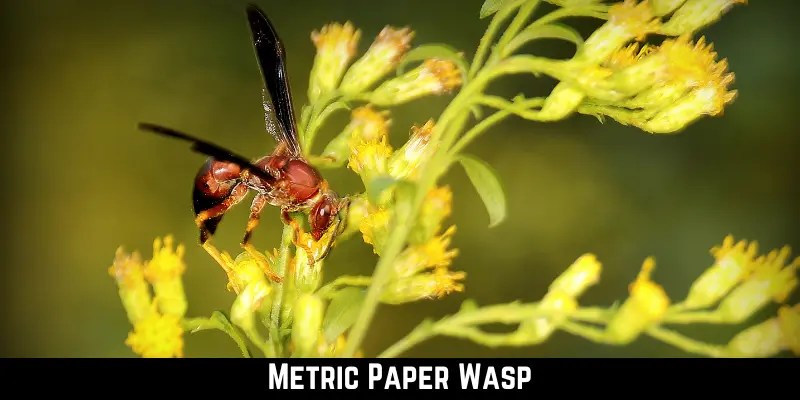You may probably see wasps buzzing in your yard and home, but have you seen dark-reddish brown wasps? If so, that might be a metric paper wasp. Now, you may wonder, what are these wasps, and what’ll happen if they bite you?
Metric paper wasps are the type of paper wasps native to America. They are known for their distinctive yellow and black coloration. Moreover, they are social insects that live in colonies, constructing papery nests typically under eaves, in trees, or in other sheltered locations.
To know more about the metric paper wasps, their habitat, nature, and behavior, read the details below. So, let’s dive into it.
What Is a Metric Paper Wasp?
Metric Paper wasp commonly known as “Polistes metrics” is a species of paper wasp and belongs to the family Vespidae. This wasp is found in North America and is known for their distinctive black and yellow coloration. It is widespread during the summer in Fontenelle Forest and Neale Woods.
You may see it gathering wood fibers for nest construction on worn wood. They frequently can be observed sucking nectar from flowers. This medium-sized wasp has a length of around 1 inch (25 mm). Its thorax and head are primarily red, with some black markings.
Although the abdomen is mostly dark brown, some wasps have a thin, yellow stripe between segments two and three of the abdomen. The antennae are primarily dark, but the base has some reddish coloring.
Moreover, as is typical for this species, the wings are dark brown and longitudinally folded. The only difference between males and females is the color of their faces: males are yellow, while females are red. One of this species’ most distinctive features is the bulge on the underside of abdominal segment 2.
Above all, it’s worth noting that these wasps can sometimes exhibit aggressive behavior, especially when they feel their nest is threatened. Some people may get severe allergic reactions from their stings.
| Taxonomy | |
| Kingdom | Animalia |
| Division | Arthropoda |
| Class | Insecta |
| Order | Hymenoptera |
| Family | Vespidae |
| Genus | Polistes |
| Species | P.metricus |
| Scientific Name | Polistes Metricus |
| Category | Bee, Ant, Wasp, and Similar |
| Size (Adult; Length) | 20mm to 35mm |
| Colors | Red, black, yellow |
| Descriptors | flying, stinging, protective, nesting in paper, redhead and torso, black bottom, and yellow legs, annoyance |
The Behavior of Metric Paper Wasp
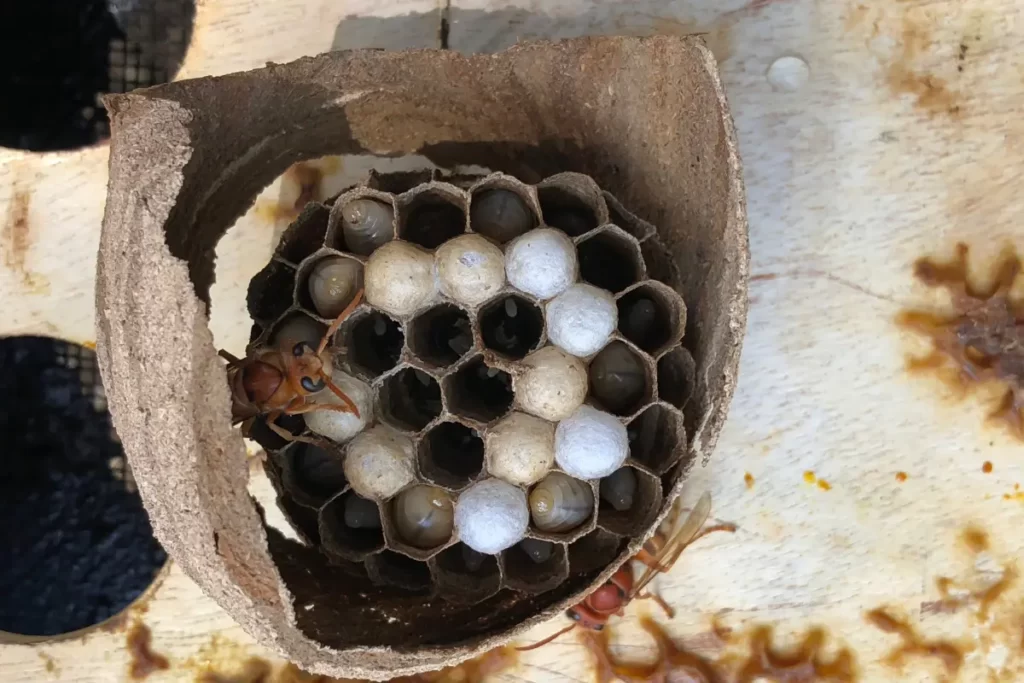
Metric paper wasps are known for their interesting behavior and social structure. These wasps have a complex social system with different castes, including queens, workers, and males.
A single overwintering queen normally emerges in the spring and establishes the colonies. As the colony grows, it produces worker wasps that assist in nest building, foraging, and caring for the young.
Moreover, metric paper wasps use plant fibers and saliva to construct their nests. These nests are typically umbrella-shaped with hexagonal cells and made of a paper-like substance. In general, paper wasps are less aggressive than some other wasp species, such as yellow jackets or hornets. But if they feel endangered or their nest is disrupted, they may sting you.
Additionally, they communicate with each other using special chemicals called pheromones. These chemical signals help them coordinate activities within the colony, such as foraging, defending the nest, and recognizing nestmates.
They also play a role in ecosystem dynamics by controlling insect populations and pollinating plants. While they can be beneficial in this regard, their presence near human habitation can sometimes lead to conflicts due to the risk of stings.
Habitat of Metric Paper Wasp
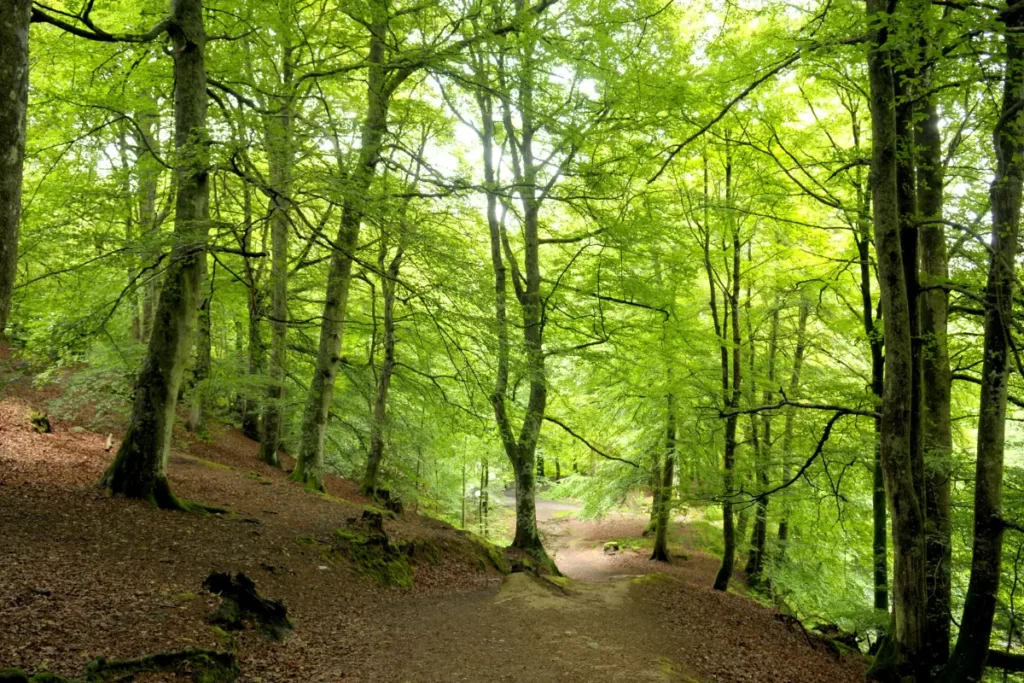
The Metric Paper Wasp (Polistes metricus) is a species of paper wasp native to North America. In addition to urban areas, woodlands, grasslands, and gardens, these wasps can be found all over the continent in various environments. They are renowned for making open-celled paper nests, which they frequently place under eaves, roofs, branches, and other protected areas.
As long as food sources (nectar, fruit, and insects) and suitable nesting sites are available, metric paper wasps may adapt to several settings and thrive there. They have a reputation for being quite opportunistic when it comes to building nests, frequently choosing spots that offer cover from the elements and a certain amount of isolation.
Remember, if their presence becomes a concern due to their proximity to human activity areas, it’s recommended to consult local pest control professionals or entomologists for advice on safe and effective management strategies.
The Life Cycle of Metric Paper Wasp
Like other paper wasps, the Metric Paper Wasp has a specific life cycle with various stages. Below is a brief review of its life cycle:
- The life cycle of metric paper wasps begins in the spring when a mated female wasp, called the foundress, emerges from overwintering. She searches for a suitable nesting site, often in protected areas like eaves, tree branches, or other sheltered spots. Once she finds a suitable location, she starts building the nest.
- After constructing the nest, the foundress lays a single egg in each cell. The eggs are tiny, elongated, and typically white or pale.
- The larvae enter the pupal stage once they have grown to a specific size and are fully developed. The pupae are enclosed within a protective silk cocoon spun by the larvae. Inside the cocoon, metamorphosis takes place as the pupae transform into adult wasps (females).
- These newly emerged female wasps become workers and take over the foraging and nest-building tasks. Further, they expand the nest, build new cells, and gather food to feed the developing larvae. The worker phase is the longest in the life cycle and continues throughout the summer.
- As summer progresses, some of the worker wasps undergo a physiological change that allows them to lay eggs. These eggs develop into male wasps and new potential foundresses. The cycle repeats itself the following spring when the mated foundresses emerge to start new nests and continue the cycle.
Do Metric Paper Wasps Fly?
Yes, metric paper wasps (Polistes metricus) are capable of flying. Paper wasps are a group of wasp species belonging to the genus Polistes. They are renowned for creating paper-like nests from chewed-up plant fibers and wood. As they fly, their long legs hang down.
Moreover, metric paper wasps, like the majority of other insects, have wings that enable them to fly. Their flight is powered by the rapid movement of their wings, which allows them to generate lift and maneuver through the air. The specifics of how they fly involve their wing structure and wing-beat pattern.
Additionally, these wasps are highly busy and quick fliers; you can frequently observe them buzzing around flowers, scavenging for insects and honey. They depend on their ability to fly for several activities in their daily lives, including finding food, locating nesting locations, and protecting their territory.
How Do You Identify Metric Paper Wasps?
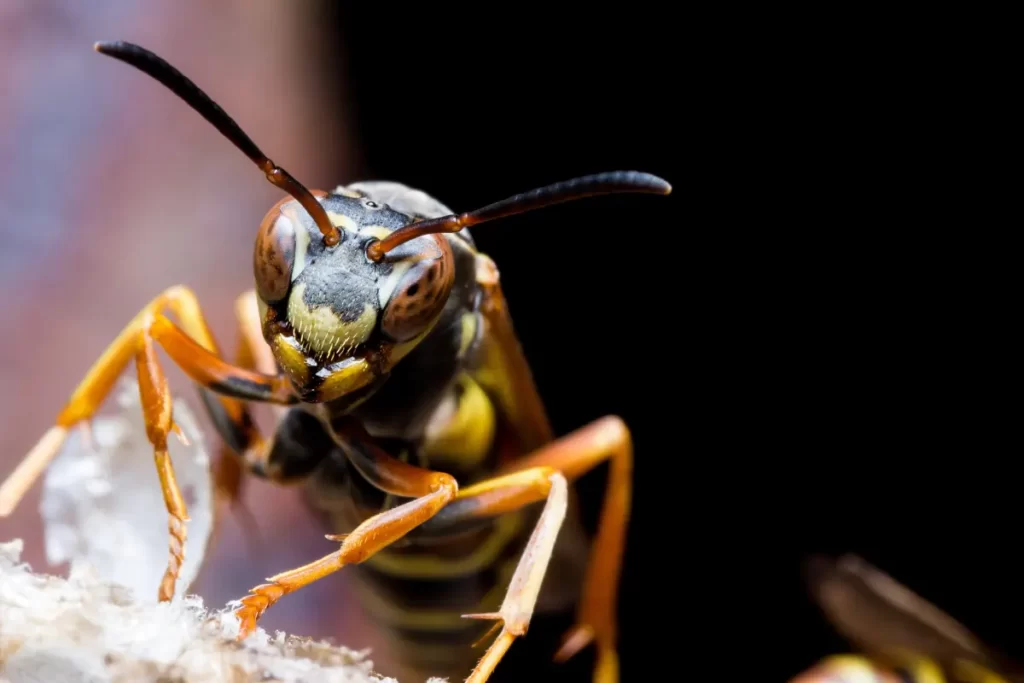
It requires extensive observation of both their physical traits and behavior to recognize metric paper wasps (Polistes metricus). Below are some distinctive features of metric paper wasps to identify them:
- Metric paper wasps are medium-sized wasps, with adults typically ranging from 0.5 to 1 inch (12 to 25 mm) in length. They have a slender body with a distinct waist between the thorax and abdomen.
- The exact coloration of metric paper wasps can vary somewhat, but they generally have a black body with yellow markings on the abdomen and thorax.
- Their head is usually black with prominent, large compound eyes on the sides of the head.
- The thorax is the middle part of their body, and it’s typically black with some yellow markings.
- Furthermore, their abdomen is connected to the thorax and is where you’ll see the most distinct yellow markings.
- When flying, metric paper wasps usually have a distinct hovering flight pattern.
What Are the Signs of a Metric Paper Wasp Infestation?
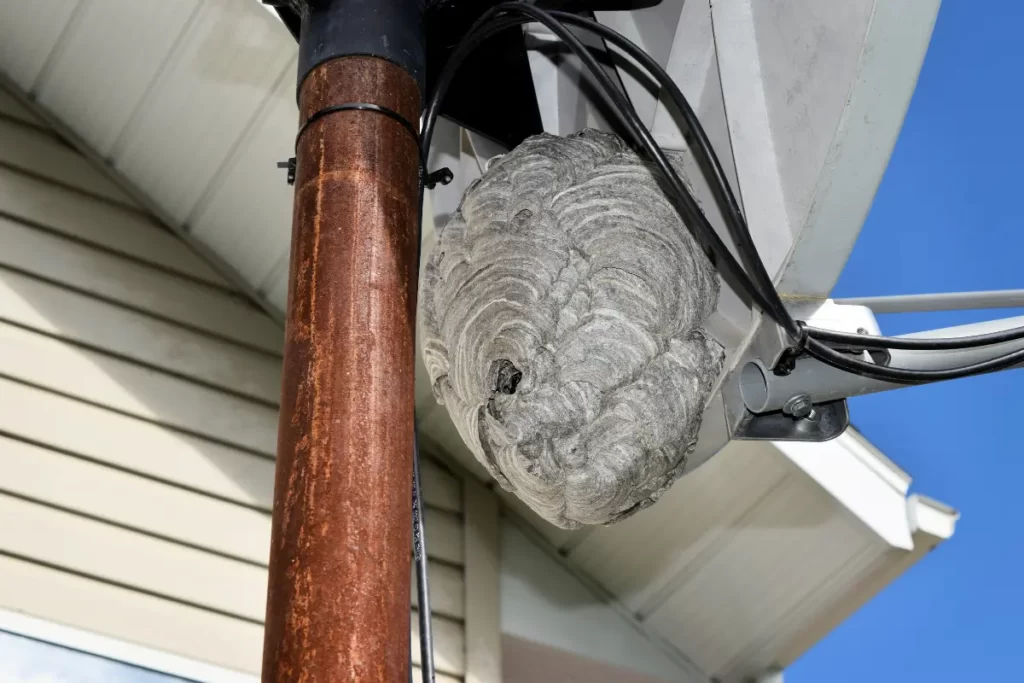
Identifying a metric paper wasp infestation is a challenging task, but below are some clues that will surely help you recognize them.
- If you notice a sudden increase in wasp activity around your property, such as a higher number of wasps flying around, or entering and exiting gaps and crevices, this could indicate an infestation.
- A significant indication of a wasp infestation is the presence of numerous nesting structures resembling layered paper combs.
- If you observe wasps guarding or hovering around a specific area, it could mean that their nest is nearby.
- Besides that, there is a greater chance of an infestation if you frequently notice a large number of wasps in one place.
- Moreover, if you notice wasps frequently visiting trash cans, outdoor eating areas, or flowering plants, it might indicate an infestation.
- Lastly, you could hear a gentle buzzing sound near their nesting locations. It is more obvious when there is a lot of activity or when the nest is disrupted.
What Are Metric Paper Wasps Attracted to?

Like many other species of wasps, metric wasps are attracted to various food sources. These wasps are opportunistic foragers, meaning they will exploit available resources in their surroundings. Here are some things that attract metric paper wasps:
- Like many other wasps and bees, metric paper wasps draw to nectar-producing flowers.
- As metric paper wasps are predators and feed on various insects, they draw to flies, caterpillars, spiders, and other small arthropods.
- Apart from nectar, paper wasps can also attract sugary substances such as fruit juices, ripe or rotting fruits, and sweet liquids.
- In urban environments, metric paper wasps might be attracted to human food, especially sugary or protein-rich items like sweet beverages, meat, and fruits.
- Furthermore, they frequently look for damp areas to get water, especially during hot, dry weather.
Eating Habits of Metric Paper Wasps
Metric paper wasps are predators, and like other paper wasps, they mostly eat insects and other arthropods for food. They may eat a range of tiny insects, including spiders, flies, caterpillars, and other soft-bodied invertebrates.
Furthermore, these wasps are renowned for their nesting habits and social organization, creating paper-like nests out of the fibers they’ve chewed up and saliva combined with them. Additionally, they supply their nests with paralyzed insects that serve as food for their developing larvae. The adult wasps primarily feed on nectar, pollen, and other sugary substances. These carbohydrate-rich foods provide them with the energy they need for flying and other activities.
In conclusion, metric paper wasps eat mostly insects and other arthropods because they need the protein for their developing larvae. As adults, they add nectar and pollen to their diets to complement their energy needs.
How Does a Metric Wasp Build Its Nest?
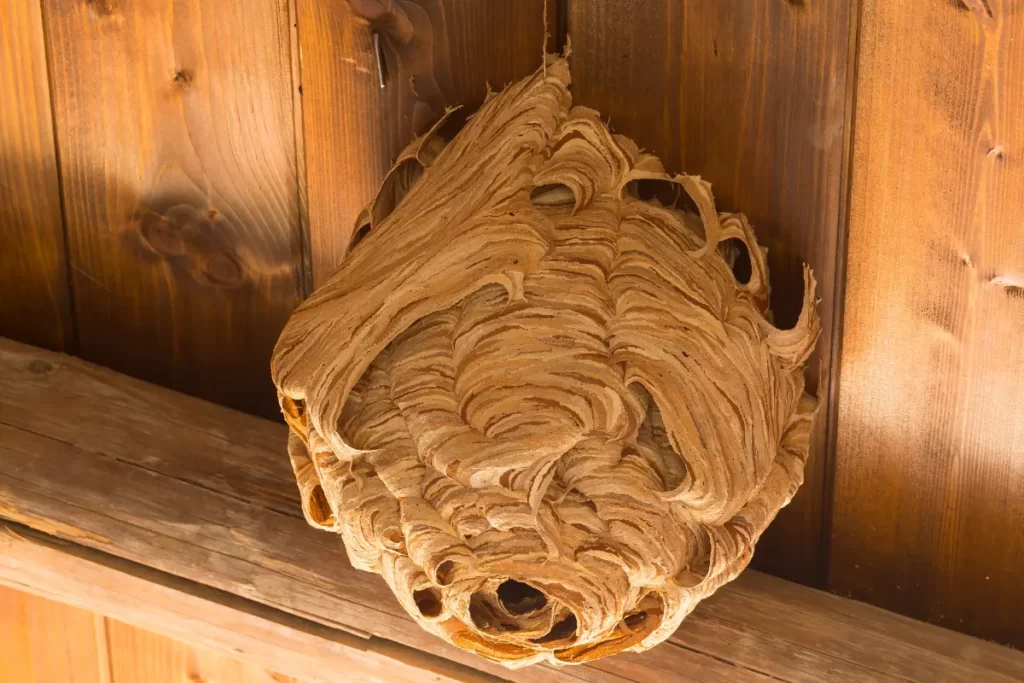
Metricus Paper Wasp wasps use paper and saliva to construct their nests. Usually, the nests are present in safe places like attics, under eaves, or in trees. They create nests by chewing wood fibers and mixing them with saliva to create a papery substance. Then they construct open, umbrella-like nests with hexagonal cells attached to a central stalk.
Additionally, metric paper wasps often choose sheltered locations that protect them from the elements and predators. Common nesting sites include the eaves of buildings, tree branches, and other similar structures. The foundress, who establishes the colony as the dominant female, starts by erecting a brief stalk.
After that, wasps start constructing cells and to make them, the wasps collect wood fibers by chewing on wood and plant materials. They mix these fibers with their saliva, creating a pulpy substance that can mold into shape. Once a cell’s walls are constructed, the foundress lays an egg inside.
As the larvae grow, they molt several times and eventually pupate inside their cells. Once they pupate, the foundress and other worker wasps seal the cells with an additional layer of paper material. As the colony grows, the wasps continue to add new cells to expand the nest.
Do Metric Paper Wasps Have Aggressive Behavior?
No, metric paper wasps, are generally not as aggressive as some other types of wasps, such as yellow jackets or hornets. However, some species of metric paper wasps (genus Polistes) can exhibit aggressive behavior, especially when their nests or territory is threatened.
Additionally, metric paper wasps are famous for their social behavior and live in colonies with a hierarchical structure. These wasps are more likely to exhibit defensive behavior rather than actively seeking out conflicts.
If you encounter a metric paper wasp nest or individual wasps, it’s best to give them space and avoid provoking them, as their aggression might increase if they perceive a threat. If you need to remove a nest or address a wasp-related issue, it’s advisable to seek assistance from professionals who can handle the situation safely.
Metric Paper Wasps Beneficial to the Environment or Not
Metric paper wasps are beneficial to the environment. Here is how:
- Pollination: Many species of metric paper wasps are pollinators, visiting flowers to feed on nectar and inadvertently transferring pollen from one flower to another. It contributes to plant reproduction and the overall health of ecosystems.
- Pest Control: Paper wasps are scavengers and predators that eat several insects, such as caterpillars and other pest insects that can harm gardens and crops. These wasps can assist in preserving ecological balance by reducing pest populations.
Apart from these benefits, they also have some negative impacts:
- Stinging Behavior: While metric paper wasps generally only sting when they feel threatened, their stings can be painful for humans and may cause allergic reactions in some individuals. It can lead to negative interactions between humans and metric paper wasps.
- Nesting Sites: Metric paper wasps build their nests in various locations, such as eaves, trees, and shrubs. While their nests are interesting and provide educational opportunities, they can also lead to conflicts with humans if they are built in high-traffic areas.
What Should You Do If a Metric Paper Wasp Bites You?

If a metric paper wasp bites you, it’s important to follow the appropriate steps. These steps are mentioned below:
- First of all, stay calm. Panicking can make the situation worse.
- If you’re near the wasp nest, move away from it to avoid further stings.
- Wash the affected area with mild soap and water to help prevent infection.
- If you see a stinger, you can gently scrape it off with a fingernail.
- Applying a cold compress or ice wrapped in a cloth to the sting site can help reduce pain and swelling. Keep it on for about 10-15 minutes, with breaks in between.
- Moreover, If you have a severe allergy to wasp stings or experience symptoms like difficulty breathing, hives, swelling of the face and throat, rapid heartbeat, or dizziness, seek medical attention immediately.
- Most importantly, if you notice increasing redness, swelling, warmth, or pus, it may indicate an infection. In this situation, consult the doctor.
How Does a Metric Paper Wasp Communicate?
Metric paper wasps usually communicate with each other through chemicals. Chemical communication is a vital aspect of social insects’ behavior. Moreover, they use pheromones to convey specific messages to other colony members. Pheromones can signal alarm, aggression, mating readiness, and even the presence of a fertile queen.
Apart from pheromones, metric paper wasps use visual and vibrational cues for communication. For visual communication, they have well-developed compound eyes that allow them to perceive different wavelengths of light. They can distinguish patterns, shapes, and movements, which they use to identify nestmates, recognize potential threats, and locate food sources.
For vibrational communication, they produce vibrations by rapidly moving their wings or body against surfaces. These vibrations can convey information to other wasps in the colony. For instance, returning foragers might produce specific vibrations upon their return to the nest, which can signal the presence of food resources and stimulate other workers to go out and forage.
Does a Metric Paper Wasp Hibernate?
Yes, most species of paper wasps, including metric paper wasps, exhibit a behavior known as “overwintering” or “hibernation” during the colder months. The wasps become less active during this time and seek cover to survive the winter. Species and geographic location can affect the particulars of this behavior.
Metric paper wasp colonies often experience population declines as the temperature drops in colder locations. The queen wasp, on the other hand, looks for protection in a protected area like behind bark or other suitable places. She enters a state where her metabolic rate slows down significantly, allowing her to conserve energy and survive until the warmer months arrive.
However, the rest of the colony, including the worker wasps and males, do not survive the winter. They die off as the weather gets colder and resources become scarcer.
How Do Metric Paper Wasps Find Their Food?
Metric paper wasps (Polistes metricus), like other paper wasp species, primarily locate their food sources through visual and olfactory cues. Here’s how they normally go about finding food:
- Visual Cues: Metric paper wasps have well-developed compound eyes that allow them to perceive different colors and patterns. They are skilled at recognizing flowers and other potential food sources based on visual cues. Further, they are attracted to bright and contrasting colors, especially shades of yellow and blue.
- Olfactory Cues: Metric paper wasps rely on their sense of smell to locate food. They are sensitive to pheromones and scents emitted by flowers, ripe fruits, and other potential food items. It helps them identify and differentiate between various food sources based on their odor profiles.
Once a paper wasp locates a food source, it will feed on nectar, fruit juices, and sometimes even small insects.
How to Prevent Metric Paper Wasps from Building Nests?
Preventing metric paper wasps from building nests around your property involves a combination of strategies to discourage their presence. Here are some steps you can take to deter them from building nests:
- Inspect your property regularly for any signs of nest construction. If you spot a nest in its early stages, remove it promptly.
- Seal any potential entry points into your home or building, such as gaps in walls, roof eaves, vents, and openings around windows and doors. It limits their access to indoor spaces, reducing the likelihood of nest-building.
- Wasps are attracted to food sources like sugary substances and proteins. Keep outdoor eating areas clean and free of spills, and ensure that trash cans are tightly sealed.
- Use wasp repellents. There are commercial wasp repellents available that can deter these insects from building nests.
- Certain essential oils, like peppermint, eucalyptus, and citronella, can act as natural deterrents for wasps. Mix a few drops of essential oil with water in a spray bottle and apply it to areas prone to nesting.
- Wasps are less attracted to yellow lighting compared to white or blue light. Consider using yellow outdoor lighting to minimize their presence.
- Lastly, If you’re dealing with a persistent wasp problem, call a professional pest control service to protect yourself.
Other Wasp Species Found in The USA
Along with metric paper waps, there are several other wasps found in the USA. You can find everything about these species here:
Conclusion
There are different types, but the metric paper wasps or Polistes metricus are the most social type. They create nests in trees and other plants or beneath the eaves of houses and docks that are gray and paper-like.
Moreover, they are known for their distinctive nests made from chewed plant fibers mixed with saliva, giving them a papery texture. They are beneficial for the ecosystem in terms of harmful pest control and pollination. However, they may sting you and cause severe allergic reactions.
To prevent yourself from painful stings or allergic reactions, you should opt for the above-mentioned preventive measures or call a professional pest control company.
